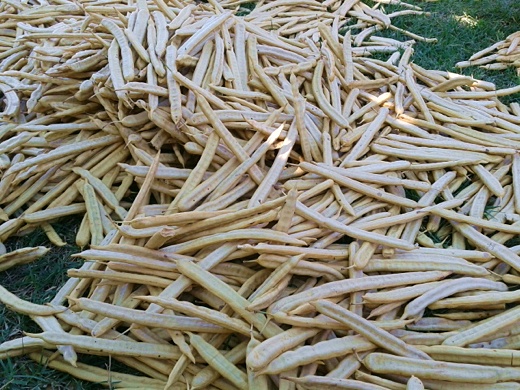SUBHEAD: Kiawe beans pods are not just food for livestock, but can be brewed to make a delicious tea.
By Mercy Ritte on 28 October 2013 for the Molokai Dispatch -
(http://themolokaidispatch.com/kiawe-beans-pods-not-just-food-for-livestock/)

Image above: Kiawe beans photo by From original article.
As you know, our kiawe trees produce an abundance of bean pods every year. Not only is it a nutritious food source for livestock, but also for people.
In its native lands, dried kiawe bean pods ground into meal or flour is considered a staple food. It is very delicious and adds a sweet nutty taste to breads, pancakes, muffins, cakes and cookies. It is also gluten free, GMO free, highly nutritious, diabetic friendly and can be used to make syrup, jelly, tea, milk, and wine.
Unlike wheat that digests within one to two hours, kiawe takes four to six hours to digest, resulting in delay of hunger pangs.
The sweetness in the kiawe bean pod comes from fructose which does not require insuilin to be metabolized and because of its high fiber content, the nutrients are absorbed which also assists in stabilizing blood sugar levels. It also contains protein and minerals such as barium, boron, calcium, chromium, obalt, copper, iron, magnesium, manganese, molybdenum, phosphorus, potatssium, sodium, sulfur, and zinc.
We were very fortunate to have Vince Kana`i Dodge and Connie “Tita” Hokoana visit from Waianae and teach a two-day kiawe workshop on Saturday and Sunday, October 19th-20th 2013.
This hands on, sensory workshop was hosted by the MOM hui and was supported by Hawaii SEED and `Ai Pohaku. Those in attendance learned to identify, gather, sort, wash, dry, and grind beans into flour. Using the flour and bean pods we also prepared and enjoyed `ono food and savory tea together.
Personally, my eyes are wide open to the limitless possibilities and uses for kiawe bean pods and the tree itself. In fact, in traditional folklore kiawe is known as a generous tree, giving abundantly of its bean pods for food and drinks, branches for firewood and building material, sweet nectar and blossoms for our bees, leaves and bark for medicine, and sap for dying. It is evident that the benefits of this tree outweigh the disadvantages and because it grows so abundant here it can serve as a valuable, sustainable food source for our Molokai families.
If you would like to learn more, email theMOMhui@gmail.com.
`Ai Pohaku Kiawe Bean Tea Recipe
Ingredients:
Fresh kiawe bean pods
Water
Directions:
Rinse kiawe bean pods if necessary, then fill pot 1/2 way. Add water to pot, until it’s 2/3 full. Bring to a rolling boil, 10-20 minutes then simmer on lowest heat for one hour. Makes beautiful dark brown sweet tea. Very tasty hot or iced!
.
By Mercy Ritte on 28 October 2013 for the Molokai Dispatch -
(http://themolokaidispatch.com/kiawe-beans-pods-not-just-food-for-livestock/)

Image above: Kiawe beans photo by From original article.
As you know, our kiawe trees produce an abundance of bean pods every year. Not only is it a nutritious food source for livestock, but also for people.
In its native lands, dried kiawe bean pods ground into meal or flour is considered a staple food. It is very delicious and adds a sweet nutty taste to breads, pancakes, muffins, cakes and cookies. It is also gluten free, GMO free, highly nutritious, diabetic friendly and can be used to make syrup, jelly, tea, milk, and wine.
Unlike wheat that digests within one to two hours, kiawe takes four to six hours to digest, resulting in delay of hunger pangs.
The sweetness in the kiawe bean pod comes from fructose which does not require insuilin to be metabolized and because of its high fiber content, the nutrients are absorbed which also assists in stabilizing blood sugar levels. It also contains protein and minerals such as barium, boron, calcium, chromium, obalt, copper, iron, magnesium, manganese, molybdenum, phosphorus, potatssium, sodium, sulfur, and zinc.
We were very fortunate to have Vince Kana`i Dodge and Connie “Tita” Hokoana visit from Waianae and teach a two-day kiawe workshop on Saturday and Sunday, October 19th-20th 2013.
This hands on, sensory workshop was hosted by the MOM hui and was supported by Hawaii SEED and `Ai Pohaku. Those in attendance learned to identify, gather, sort, wash, dry, and grind beans into flour. Using the flour and bean pods we also prepared and enjoyed `ono food and savory tea together.
Personally, my eyes are wide open to the limitless possibilities and uses for kiawe bean pods and the tree itself. In fact, in traditional folklore kiawe is known as a generous tree, giving abundantly of its bean pods for food and drinks, branches for firewood and building material, sweet nectar and blossoms for our bees, leaves and bark for medicine, and sap for dying. It is evident that the benefits of this tree outweigh the disadvantages and because it grows so abundant here it can serve as a valuable, sustainable food source for our Molokai families.
If you would like to learn more, email theMOMhui@gmail.com.
`Ai Pohaku Kiawe Bean Tea Recipe
Ingredients:
Fresh kiawe bean pods
Water
Directions:
Rinse kiawe bean pods if necessary, then fill pot 1/2 way. Add water to pot, until it’s 2/3 full. Bring to a rolling boil, 10-20 minutes then simmer on lowest heat for one hour. Makes beautiful dark brown sweet tea. Very tasty hot or iced!
.
No comments :
Post a Comment